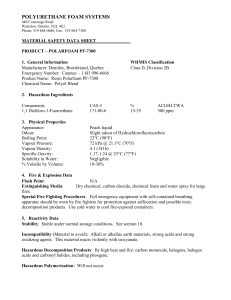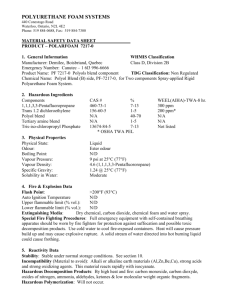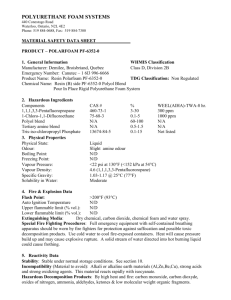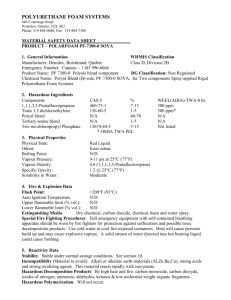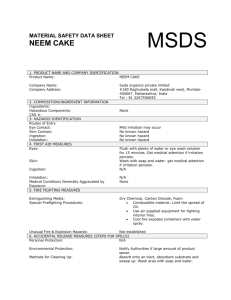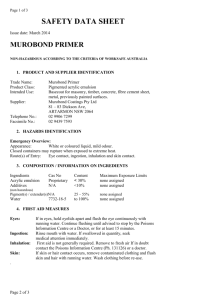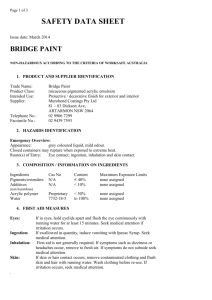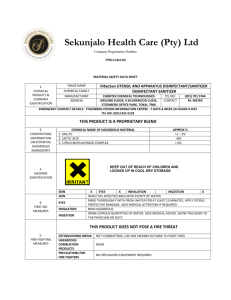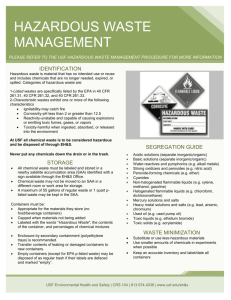POLYURETHANE FOAM SYSTEMS INC
advertisement
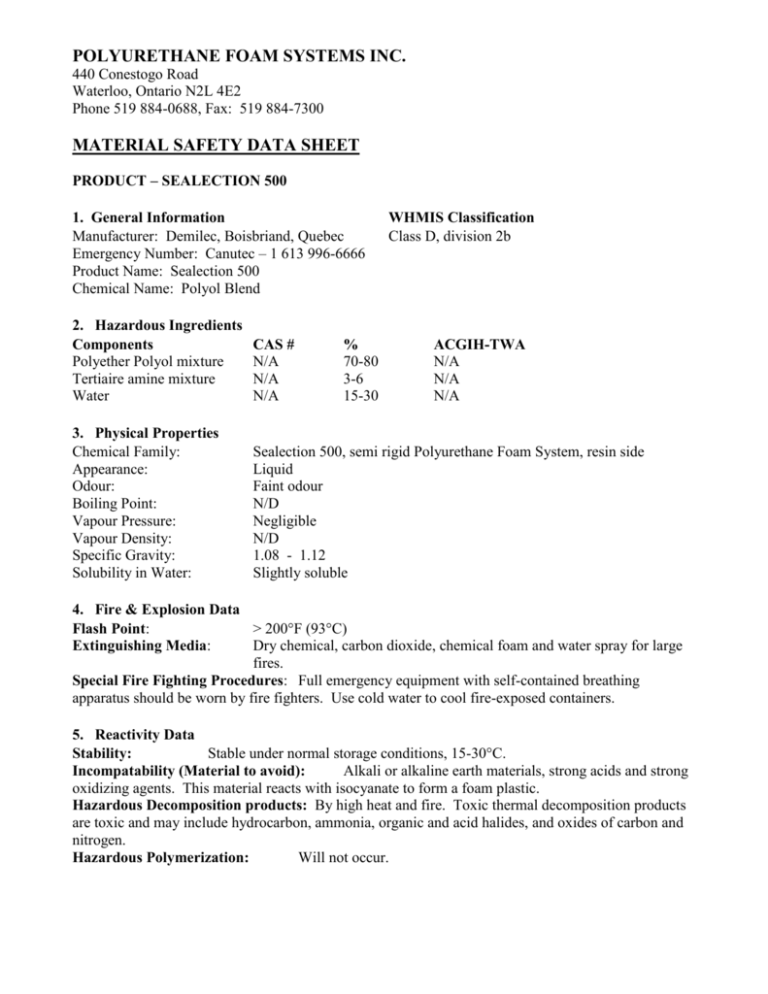
POLYURETHANE FOAM SYSTEMS INC. 440 Conestogo Road Waterloo, Ontario N2L 4E2 Phone 519 884-0688, Fax: 519 884-7300 MATERIAL SAFETY DATA SHEET PRODUCT – SEALECTION 500 1. General Information Manufacturer: Demilec, Boisbriand, Quebec Emergency Number: Canutec – 1 613 996-6666 Product Name: Sealection 500 Chemical Name: Polyol Blend WHMIS Classification Class D, division 2b 2. Hazardous Ingredients Components Polyether Polyol mixture Tertiaire amine mixture Water CAS # N/A N/A N/A 3. Physical Properties Chemical Family: Appearance: Odour: Boiling Point: Vapour Pressure: Vapour Density: Specific Gravity: Solubility in Water: Sealection 500, semi rigid Polyurethane Foam System, resin side Liquid Faint odour N/D Negligible N/D 1.08 - 1.12 Slightly soluble % 70-80 3-6 15-30 ACGIH-TWA N/A N/A N/A 4. Fire & Explosion Data Flash Point: > 200°F (93°C) Extinguishing Media: Dry chemical, carbon dioxide, chemical foam and water spray for large fires. Special Fire Fighting Procedures: Full emergency equipment with self-contained breathing apparatus should be worn by fire fighters. Use cold water to cool fire-exposed containers. 5. Reactivity Data Stability: Stable under normal storage conditions, 15-30°C. Incompatability (Material to avoid): Alkali or alkaline earth materials, strong acids and strong oxidizing agents. This material reacts with isocyanate to form a foam plastic. Hazardous Decomposition products: By high heat and fire. Toxic thermal decomposition products are toxic and may include hydrocarbon, ammonia, organic and acid halides, and oxides of carbon and nitrogen. Hazardous Polymerization: Will not occur. 6. Health Hazard Data Eye Contact: May cause moderate eye irritation and corneal injury. May be slow to heal, with possible permanent impairment vision. Skin Contact: Moderately irritating. Causes redness, oedema or drying of skin. Ingestion: May cause nausea, abdominal pains, bronchopneumonia or pulmonary oedema. Inhalation: May cause headaches, dizziness, anesthesia, drowsiness and other central nervous system effects. 7. First Aid Procedures Eye Contact: Flush with running water for at least 15 minutes, holding eyelids open. Obtain medical attention. Skin Contact: Remove contaminated clothing. Wash affected areas with soap and water for at least 15 minutes. Wash contaminated clothing before reuse. Ingestion: If conscious, rinse out mouth and give 250 ml of milk or water to dilute material. Do not induce vomiting. DO NOT GIVE ANYTHING BY MOUTH TO AN UNCONSCIOUS PERSON. Obtain immediate medical attention. Inhalation: Remove patient to an area free from further exposure. Administer artificial respiration as needed. Obtain immediate medical attention. 8. Spill or Leak Procedures Action to Take for Spills/Leaks: Absorb with sawdust or other absorbent. Shovel into suitable unsealed containers. Clean-up: Wash down surfaces with soap and warm water. Waste Disposal: Dispose of waste according to federal, provincial and local regulations. Consult an expert on the disposal of recovered material. 9. Handling Precautions Eye Protection: Use safety glasses or chemical goggles when there is potential for eye contact. Skin Protection: Use protective clothing impervious to chemicals. Selection of specific items such as gloves, boots or apron will depend on operation. Ventilation: Local exhaust should be used to maintain a fresh supply of air or an air-supplied respirator should be worn in the case of none ventilated processing area. 10. Storage and Handling Storage Temperature (min.-max.): 15-30°C (59-86°F) Precaution to be taken in Storage and Handling: Store in tightly closed containers in a cool, dry place. Avoid breathing vapours and contact with eyes or skin. Sealection 500, Pg. 2 11. Shipping Date Technical Shipping Name: T.G.D. Classification: IMO: IATA/ICAO Class: Polyol blend, Sealection 500 component Non-regulated Non-regulated Non-regulated 12. Other Information WHMIS-Workplace Hazardous Materials Information System – Description - Class D-2: Materials causing other toxic effects – a poisonous substance that may be immediately dangerous to health – may cause death or permanent damage as a result of repeated exposures over time – may be a sensitizer (produce chemical allergies) – may cause cancer, birth defects or sterility. January 10, 2006 Sealection 500, Pg. 3
